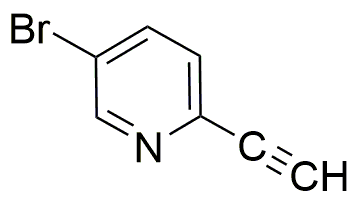5-Bromo-2-ethynylpyridine is widely utilized in research focused on:
- Pharmaceutical Development: This compound is a key intermediate in the synthesis of various pharmaceuticals, particularly in creating novel drugs that target specific biological pathways.
- Material Science: It is used in the development of advanced materials, including polymers and coatings, due to its unique chemical properties that enhance material strength and durability.
- Organic Synthesis: Researchers leverage its reactivity in organic synthesis to create complex molecules, making it valuable in academic and industrial laboratories for producing fine chemicals.
- Biochemical Research: The compound serves as a probe in biochemical studies, helping scientists understand enzyme mechanisms and interactions within biological systems.
- Agricultural Chemistry: It finds applications in the formulation of agrochemicals, contributing to the development of effective pesticides and herbicides that improve crop yields.
General Information
Properties
Safety and Regulations
Applications
5-Bromo-2-ethynylpyridine is widely utilized in research focused on:
- Pharmaceutical Development: This compound is a key intermediate in the synthesis of various pharmaceuticals, particularly in creating novel drugs that target specific biological pathways.
- Material Science: It is used in the development of advanced materials, including polymers and coatings, due to its unique chemical properties that enhance material strength and durability.
- Organic Synthesis: Researchers leverage its reactivity in organic synthesis to create complex molecules, making it valuable in academic and industrial laboratories for producing fine chemicals.
- Biochemical Research: The compound serves as a probe in biochemical studies, helping scientists understand enzyme mechanisms and interactions within biological systems.
- Agricultural Chemistry: It finds applications in the formulation of agrochemicals, contributing to the development of effective pesticides and herbicides that improve crop yields.
Documents
Safety Data Sheets (SDS)
The SDS provides comprehensive safety information on handling, storage, and disposal of the product.
Product Specification (PS)
The PS provides a comprehensive breakdown of the product’s properties, including chemical composition, physical state, purity, and storage requirements. It also details acceptable quality ranges and the product's intended applications.
Certificates of Analysis (COA)
Search for Certificates of Analysis (COA) by entering the products Lot Number. Lot and Batch Numbers can be found on a product’s label following the words ‘Lot’ or ‘Batch’.
*Catalog Number
*Lot Number
Certificates Of Origin (COO)
This COO confirms the country where the product was manufactured, and also details the materials and components used in it and whether it is derived from natural, synthetic, or other specific sources. This certificate may be required for customs, trade, and regulatory compliance.
*Catalog Number
*Lot Number
Safety Data Sheets (SDS)
The SDS provides comprehensive safety information on handling, storage, and disposal of the product.
DownloadProduct Specification (PS)
The PS provides a comprehensive breakdown of the product’s properties, including chemical composition, physical state, purity, and storage requirements. It also details acceptable quality ranges and the product's intended applications.
DownloadCertificates of Analysis (COA)
Search for Certificates of Analysis (COA) by entering the products Lot Number. Lot and Batch Numbers can be found on a product’s label following the words ‘Lot’ or ‘Batch’.
*Catalog Number
*Lot Number
Certificates Of Origin (COO)
This COO confirms the country where the product was manufactured, and also details the materials and components used in it and whether it is derived from natural, synthetic, or other specific sources. This certificate may be required for customs, trade, and regulatory compliance.


